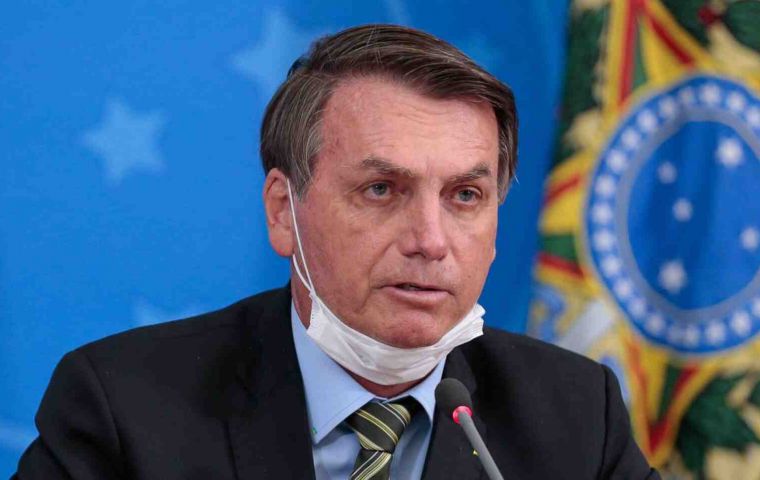MercoPress. South Atlantic News Agency
Poverty on the rise in Brazil
 Disregarding the pandemic in the name of economic achievements seems not to be working for Bolsonaro, according to the press
Disregarding the pandemic in the name of economic achievements seems not to be working for Bolsonaro, according to the press Brazil's poverty indexes are on the rise despite President Jair Bolsonaro's claims that his actions, however controversial from a sanitary viewpoint regarding the COVID-19 pandemic, were always aimed at sustaining the country's economy.
In this regard, Bolsonaro's recent decision to severely cut down the government's budget for scientific research will most likely paralyze the sector and the livelihoods of people working on it.
At the same time, corruption seems to be surrounding both the federal government as well as members of the presidential family, including Bolsonaro's wife and children, while the President insists on parading nationwide, opening bridges ten meters long and five meters wide in an anticipated campaign for next year's elections.
The President continues to criticize the use of masks and questions the effectiveness of vaccines against COVID-19, while at the same time he favours the use of drugs the scientific community has not openly endorsed. Brazil ranks third worldwide in the number of people vaccinated, but also when it comes to numbers proportional to the population, it ranks only 66th, while in COVID-19 deaths it ranks second to the United States.
In addition to pandemic data, poverty and hunger are growing. Since Bolsonaro took office at least 20 million Brazilians have fallen under the line of misery which was reportedly eliminated under Luiz Inácio Lula da Silva (2003-2010). And in the last six months, that degradation has reached breakneck speed. They are repeated throughout the country, from metropolis to small municipalities, scenes of lines of people searching for remains in butchers and supermarkets, hoping to return home with chicken legs and necks or ox bones.
To make matters worse, retailers now sell what used to be trash content - A kilo of chicken feet sells for about US $ 0.75 and of ox bone for US $ 1, according to press reports.
The number of Brazilians living on the streets in large cities has doubled since the middle of last year. In São Paulo, the largest South American metropolis, it is estimated that they went from around 90,000 to almost 250,000. In Rio, there are no official calculations, but at first, glance what is observed is an unbridled multiplication, especially in the neighbourhoods of the middle and upper-middle class.
The number of children and adolescents selling whatever they can at traffic lights while living with their families in blankets spread out on the sidewalks has grown considerably.
According to a study, 55% of the Brazilian population, 117 million people, suffered some kind of food insecurity in 2020, it was reported last week. In Brazil, about 20 million people go without eating anything for 24 hours every few days, while 24.5 million start the day without knowing what or how they will eat. Another 74 million people could experience these situations at any time. Is that more than half of the population of Brazil, 55%, approximately 117 million people, suffered some type of food insecurity (severe, moderate or mild) in December 2020.
These data were released by Folha de São Paulo, based on a study carried out by the Brazilian Research Network on Food and Nutrition Sovereignty and Security (Rede Penssan). The research was based on official data (the permanent survey of hours and the family budget survey), and on a face-to-face survey in 1,662 urban and 518 rural households in December 2020. The data do not contemplate the increase in inflation that Brazil is experiencing since the beginning of the year.
The worst levels of food insecurity are registered in the north and northeast of Brazil: severe insecurity affects 18% of the population and 14% of households respectively when the national average is 9%. Folha also points out, based on official sources, that the total number of “irregular agglomerations” (marginal neighbourhoods or favelas), that is, precarious settlements that do not have sanitation, increased from 6,329 in 2010 to 13,151 in 2019.
Irregular housing went from 3.2 million to 5.1 million. The data for 2010 are from the national census and those for 2019 are estimates prepared by IBGE, to plan the next census that will take place next year.
One out of every four precarious homes is in the states of São Paulo and Rio de Janeiro, while the north and northeast once again have the worst housing situations in the country. In Bethlehem, the capital of the state of Pará, precarious homes are 55.5% of the total; in Manaus, capital of the state of Amazonas, they are 53%, and in Salvador, capital of Bahia, they reach 42%.




Top Comments
Disclaimer & comment rulesCommenting for this story is now closed.
If you have a Facebook account, become a fan and comment on our Facebook Page!